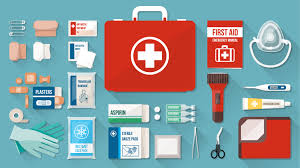Last weekend, I completed and passed my Standard First Aid Course. My course spanned over two days, approximately 8 hours on each day. I feel that the course can be shortened if the trainers did not dwell so much on their personal stories (which some were not very relevant and I suspect exaggerations…).
I will be receiving the license shortly which will allow me to provide basic first aid for two years, afterwhich I will have to attend and pass a refresher course to renew my license every two years. I strongly encourage anyone reading this post to attend one! Who knows, you may be able to save the lives of your loved ones during an emergency.
Theory
The total number of slides I received was 212. Sounds daunting but trust me it is not that difficult! I have summarised the key points that you have to know before taking the Theory Test below. The test typically consists of 30 MCQs.
Things to know and memorise:
– First Aid is a form of emergency care/treatment to anyone who is injured or suddenly ill, before the arrival of doctor/nurse/paramedic. (Non-invasive treatment only!)
– Reduce contact with body fluids: PPE > Gloves > Plastic bags > Bare Hands (To wash thoroughly afterwards!)
– Primary Survey: “DRSABC” (AKA Doctors ABC) [This is very important as it will be tested in both theory and practical. D for Danger, R for Response, S for Shout, A for AED, B for breathing, C for Continuous Chest Compressions]
– Recovery Position [To remember that if victim is breathing and unconscious, we have to put them in the recovery position to keep airway open until the paramedics arrive.]
( I was introduced to “My Responder App” which I find the function of locating the nearest AED super useful.)
| Injuries | Key Points to Note |
|---|---|
| Head Injury | Do not shift or move victim unless in danger. |
| Heat Disorders | Help to move victim to a cool place, during severe cases, wrap the victim in cool wet sheet until body temperature falls to 38 degree Celsius. |
| Fits/Convulsion/ Seizure/Epilepsy | Do not put hard objects in the victim’s mouth, try to prevent victim from injuring himself/herself. |
| Fainting | Riase legs to improve blood flow to brain. |
| Diabetic Emergencies | If victim has low blood sugar, provide surgery drinks or sweets to victim. |
| Stroke | “FAST” (F for Face, A for Arms, S for Speech, T for Time) helps you to determine if the person is having a stroke. |
| Choking | Abdominal thrust for victims whom you are certain that they are choking. Chest thrust is to be performed on obese or pregnant victims. |
| Hyperventilation | Due to hyperventilation, there will be deficiency of carbon dioxide in the body. Do not use a paper bag to breathe in exhaled air again. |
| Bleeding | Direct pressure should be applied on the wound. Tourniquet is the last resort. |
| Fractures | An open fracture refers to a fracture in which there is an open wound or break in the skin near the site of the broken bone. Using a splint to secure to body part helps to reduce pain. |
| Soft Tissue Injuries | “RICE” (R for rest, I for ice, C for compression, E for elevate) |
| Burns | Wrap casualty with a big sheet of wet material if available and lie him/her on the ground and roll him/her. |
| Heart Attack | Occurs when one of the coronary arteries is blocked by cholestorl deposits and/or blood clots. Place casualty in a comfortable position and assist him/her with own medication (if available). |
Practical
Bandages: You will be taught how to use a triangular bandage and a roller bandage. For triangular bandage, you will be required to learn how to make a broad and narrow bandage, how to tie a reef knot and how to make an arm sling and an elevation sling.
Cardio Pulmonary Resuscitation (CPR): Mouth-to-mouth resuscitation is no longer a must. However, one can still perform mouth-to-mouth resuscitation if one is comfortable with it. Elbows should be locked, only heels of palm should be touching victim to direct force towards lower part of sternum.
| Automated External Defibrillator (AED) | |
|---|---|
| Purpose | To be performed with CPR to increase the chances of survival during a sudden cardiac arrest. |
| Function | It detects and analyses the heart rhythm to prompt the operator whether defibrillation is required. When a shockable rhythm (Ventricular Fibrillation) is detected, shock will be advised. |
| Recommendation | The usual AED is recommended for use on children above the age of 8 and the weight requirement is at least 25 kg. |
| AED Dangers | Exclude AED dangers, namely metal, water and gas, before setting up AED. |
| Chest Preparation | Cut/remove clothing > Move necklaces away from the path between the pads > Shave hair at pads areas if necessary > Dry wet chest > Remove medication patches > Place pads four fingers away from Pacemaker (if applicable). |
| Placement of Pads | The electrode pads are to be placed one to the right below the collar bone and another below the left nipple. |
| Arrival of Paramedics | To report the estimated duration of CPR performed and the number of shock given to the victim. To ask paramedics for the hospital which the victim will be sent to, and return AED to owner. |
Save lives, be a first aider 🙂
Stay Safe,
PinkOlifant
